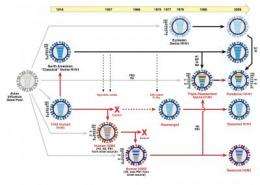Dynasty: Influenza virus in 1918 and today

The influenza virus that wreaked worldwide havoc in 1918-1919 founded a viral dynasty that persists to this day, according to scientists from the National Institute of Allergy and Infectious Diseases (NIAID), part of the National Institutes of Health. In an article published online on June 29 by the New England Journal of Medicine, authors Anthony S. Fauci, M.D., Jeffery K. Taubenberger, M.D., Ph.D., and David M. Morens, M.D., argue that we have lived in an influenza pandemic era since 1918, and they describe how the novel 2009 H1N1 virus now circling the globe is yet another manifestation of this enduring viral family.
"The 1918-1919 influenza pandemic was a defining event in the history of public health," says NIAID Director Dr. Fauci. "The legacy of that pandemic lives on in many ways, including the fact that the descendents of the 1918 virus have continued to circulate for nine decades."
Influenza viruses have eight genes, two of which code for virus surface proteins--hemagglutinin (H) and neuraminidase (N)—that allow the virus to enter a host cell and spread from cell to cell. There are 16 H subtypes and 9 N subtypes, and, therefore, 144 possible HN combinations. However, only three (H1N1, H2N2 and H3N2) have ever been found in influenza viruses that are fully adapted to infect humans. Other combinations, such as avian influenza H5N1, occasionally infect people, but they are bird viruses, not human viruses.
"The eight influenza genes can be thought of as players on a team: Certain combinations of players may arise through chance and endow the virus with new abilities, such as the ability to infect a new type of host," says Dr. Morens, Senior Advisor to the NIAID Director. That is likely what happened to spark the 1918 pandemic, he adds. Scientists have shown that the founding virus was an avian-like virus. The virus had a novel set of eight genes and—through still-unknown mechanisms—gained the ability to infect people and spread readily from person to person.
Not only did the 1918 H1N1 virus set off an explosive pandemic in which tens of millions died, during the pandemic the virus was transmitted from humans to pigs, where—as it does in people—it continues to evolve to this day. "Ever since 1918, this tenacious virus has drawn on a bag of evolutionary tricks to survive in one form or another…and to spawn a host of novel progeny viruses with novel gene constellations, through the periodic importation or exportation of viral genes," write the NIAID authors.
"All human-adapted influenza A viruses of today—both seasonal variations and those that caused more dramatic pandemics—are descendents, direct or indirect, of that founding virus," notes Dr. Taubenberger, Senior Investigator in NIAID's Laboratory of Infectious Diseases. "Thus we can be said to be living in a pandemic era that began in 1918."
How exactly do new influenza gene teams make the leap from aquatic birds to a new host, such as people or other mammals? What factors determine whether infection in a new host yields a dead-end infection or sustained, human-to-human transmission, as happened in 1918? Research on such topics is intense, but at this time definitive answers remain elusive, notes Dr. Morens.
It is known that the human immune system mounts a defense against the influenza virus's H and N proteins, primarily in the form of antibodies. But as population-wide immunity to any new variant of flu arises, the virus reacts by changing in large and small ways that make it more difficult for antibodies to recognize it. For nearly a century, then, the immune system has been engaged in a complicated pas de deux with the 1918 influenza virus and its progeny, say the NIAID authors. The partners in this dance are linked in an endless effort to take the lead from the other.
While the dynasty founded by the virus of 1918 shows little evidence of being overthrown, the NIAID authors note that there may be some cause for optimism. When viewed through a long lens of many decades, it does appear that successive pandemics and outbreaks caused by later generations of the 1918 influenza dynasty are decreasing in severity, notes Dr. Morens. This is due in part to advances in medicine and public health measures, he says, but this trend also may reflect viral evolutionary pathways that favor increases in the virus's ability to spread from host to host, combined with decreases in its tendency to kill those hosts.
"Although we must be prepared to deal with the possibility of a new and clinically severe influenza pandemic caused by an entirely new virus, we must also understand in greater depth, and continue to explore, the determinants and dynamics of the pandemic era in which we live," conclude the authors.
Source: NIH/National Institute of Allergy and Infectious Diseases (news : web)















